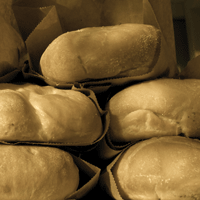Chefs are responding to diners’ call for more gluten-free, whole-grain artisanal breads
There was a time when a basic white roll would be the perfect prelude to a restaurant meal, but today’s bread basket is almost as diverse as the menu itself. From chewy French baguettes and seedy sourdoughs, to savoury scones, twisted cheese sticks, warm naan and crunchy lavash crackers, diners are drawn to the bread at top-table establishments and casual sandwich shops alike.
And there’s no doubt our tastes — and expectations — for bread are rising. According to the Chicago-based research firm Technomic’s Canadian consumer trend surveys, 39 per cent of consumers say it’s important for restaurants to offer a variety of sandwich breads, and a similar number want more sandwiches made with natural ingredients. The restaurant industry is listening — a survey of limited-service-and fast-service-restaurant chain menus found the number of whole-grain offerings nearly doubled between 2008 and 2010.
So, unless you’re under 10 or forced to grab lunch from the gas-station cooler, it’s unlikely you would choose that squishy white bread of old. In fact, a good, hearty loaf of bread has become such a sought-after product for the average consumer that the best bakers are responding to all of the top trends in bread, from local and seasonal ingredients to hands-on, artisan methods, literally taking days to mix, proof and bake a single loaf. And, you don’t have to be in a major city to find exceptional bread.
“I’ve been baking here for six years — it’s been quite a ride,” says German-born baker Monika Walker of Okanagan Grocery Artisan Breads in Kelowna, B.C. “The valley hugs me.”
No surprise there. Walker was a pioneer, bringing her delicious, hand-formed, creative artisan bread to the land of peaches and beaches. Every morning the wooden shelves lining her little shop are bursting with fat new loaves — round boules of sourdough, blueberry brioche, olive and artichoke focaccia, swirled peanut butter and jelly bread, and, the Saturday special, pain au chocolat. Even top local chefs like Rod Butters of Raudz serve her luscious loaves.
And, Walker has created custom breads for city chefs — like the black-fig-and-anise loaf Butters uses for his signature grilled salmon BLT or the crusty country baguettes she creates exclusively for chef and sommelier Mark Filatow at the Waterfront Restaurant & Wine Bar. “He’s a purest — it’s all about great bread and local cheeses,” Walker says of Filatow.
But she’s a purist, too, using local fruit in her baking by pitting fresh cherries and canning peaches and raspberries every summer. To learn about artisan baking, Walker immersed herself in the night shift at the Mix bakery in Vancouver, where seasonal breads such as walnut scallion or cranberry-ginger citrus share shelf space with caramel-apple galettes and dulce-de-leche cheesecakes.
“So few bakeries do scratch baking, but I learned the secrets of wild yeast sourdoughs there,” she says. “I did a lot of experimenting, lots of trials and errors.”
She learned, for example, red wine kills the yeast in a red wine, fig and walnut dough and that every flour, from rye to spelt, has a different protein and gluten content and needs special care. Walker does long “pre-ferments” with a portion of each batch, roasting and soaking seeds and whole grains to “pre-digest” some of the proteins.
“It creates layers of flavour,” she says. “We’re still studying and perfecting our art, but anyone can make bread. It’s a formula.”
Many top restaurants rely on artisan bakers like Walker for bread. Chef Marc Thuet supplies the Oliver Bonacini restaurants (from Canoe to Biff ’s Bistro), the Black Hoof, and the new Ritz-Carlton hotel with artisan breads from his Petite Thuet shops in Toronto. Lesley Mattina, owner of OMG Baked Goodness, supplies her focaccia with garlic oil and sea salt to Toronto’s Enoteca Sociale. And, in Calgary, the baguette from Manuel Latruwe Belgian Patisserie and Bread Shop is on the menu at several local restaurants, from the foie gras torchon sandwiches at L’Epicerie to the cheese and charcuterie platters at Farm.
Beyond the bread basket, the growing popularity of sandwiches is adding to the bottom line. Whether it’s burgers and chicken sandwiches in fast-food restaurants, or designer sandwich shops, bakery cafés and gourmet casual restaurants, the sandwich is a popular menu item.
According to the world-renowned rating system Zagat, Panera Bread is one of the most popular restaurants in North America, seen by many as North America’s healthiest fast-casual chain. They now have 1,467 locations in 40 states and have been moving into Ontario, with their artisan bread and sandwich concept.
But Canada has its own unique bakery cafés, too, from three Petite Thuet locations selling artisan bread and sandwiches, to Toronto’s new Woodlot, a funky bakery/coffee shop by day and hip, homey supper club by night. Calgary-based Good Earth cafés, pairs ethical coffee and homestyle baking with fresh soups and sandwiches at 30 spots across Western Canada. And Vancouver’s Terra Breads serves a daily soup-and-sandwich special in its bakery cafés, while selling artisan and organic breads in-house, to grocers and chefs around the city.
At Vancouver’s popular Meat & Bread, sandwiches are the staple. The meat on the menu includes three, ever-changing choices — such as meatballs, organic turkey thigh or slow-roasted porchetta with crispy crackling ($8), carved to order — and the bread, a custom-baked ciabatta bun, is supplied fresh from the local Swiss Bakery. It makes a simple yet effective vehicle for the perfect sandwich.
It’s the individual ciabatta bun that delivers the tender local rotisserie pork, beef, chicken and lamb in the sandwiches at Calgary’s Boxwood, too. But, even in his tiny kitchen space, chef Andy Bujak insists on baking in-house. “The ciabatta is pretty common, but as an individual bun it makes a good sandwich,” says Bujak, who was the full-time baker at sister restaurant River Café for four years before Boxwood opened last fall. “The texture is chewy, and it’s able to absorb sauces and moisture from tomatoes without falling apart. Ours is a natural sourdough, so it has a great flavour.”
The Boxwood bakers turn out two or three different breads daily, plus a focaccia-style flatbread, topped with local goat cheese, tomatoes and herbs as well as a variety of cookies, brownies, muffins and scones using seasonal, local ingredients. They also sell their popular multigrain sourdough bread by the loaf ($5) and make crackers and breads for the bread basket. But it’s a menu item “only for people who want it,” says Bujak, of Boxwood’s bread-and-butter side ($4) with house-churned butter.
Like much of the food here, the flour used in the bakery is organic, with about half milled from local Red Fife wheat. “Red Fife doesn’t develop as much gluten as other flour, so we mix it about 50:50,” says Bujak. “And, with our sourdough levain, we let our breads sit for 36 to 48 hours, soaking the grain, so it’s easier to digest.”
As it turns out, more diners are seeking gluten-free or low-gluten options. In a Canadian Restaurant and Foodservices Association survey, chefs put gluten-free cuisine and gluten-free beer on their list of 10 up-and-coming Canadian menu trends. Technomic’s survey also found the trend toward gluten-free foods growing, perceived by some as a healthier option. “Gluten-free is big on menus, both in the U.S. and Canada,” says Technomic’s Sara Monnette, director of Consumer Research. “It’s something consumers are demanding.”
One in 133 Canadians has celiac disease, and it’s estimated up to one-third of the country’s population is gluten-intolerant. Some blame this growing problem on our high-gluten modern wheat hybrids and the “instant”-yeast style of commercial baking, along with additives, bleaching agents and conditioners found in commercial flours. While many grains (including wheat, rye, spelt, emmer and barley) contain gluten, older varieties, such as heritage Red Fife wheat, contain far less gluten than today’s high-protein bread flours and are reportedly easier to digest. Soaking grains and flours — part of the natural fermentation process used with a natural sourdough starter or levain process — helps break down and digest proteins, too.
At Edible Canada, the new locovore bistro at Vancouver’s Granville Island Market, Eric Pateman addresses gluten intolerance. “The menu is predominantly seasonal, market-inspired cuisine, but bread is a big portion of it,” says Pateman who has been serving breakfast, lunch and dinner to 1,000 customers a day since the restaurant opened in July. “It’s the bread that really makes the sandwich, so we spent a lot of time sourcing our breads,” he adds.
From the 30-inch long rustic Portuguese roll from Swiss Bakery, to specialty breads from Terra Breads and La Baguette, Edible’s bistro chef Jennifer Dodd uses various breads for menu items, ranging from her scrambled-egg-and-smoked-cheddar breakfast bun ($4) to the cornmeal-crusted Fanny Bay oyster sandwich ($8) and the artisan bread basket ($3.50), which comes with lobster oil and Okanagan pinot noir balsamic for dipping.
And, while it’s not a gluten-free kitchen, 70 per cent of the menu is, with bread options from the local High Crow Gluten Free Foods. “Four of our staff — including myself — is celiac,” says Pateman. “We’ll have different burger buns, sandwich breads and even gluten-free bread crumbs for our onion rings and fish and chips.”
Like Pateman, most leave gluten-free baking to the experts. In Calgary, master baker Brian Hinton focuses almost exclusively on organic, gluten-free baking. With his new gluten-free Lakeview Bakery and a host of hotel, restaurant and retail clientele for his wholesale breads — Hinton is Calgary’s gluten-free guru. “We do cakes, buns, wedding cakes and an enormous amount of muffins,” says Hinton whose customers love his rice-flour brownies, chocolate-coconut haystack and oatmeal-raisin cookies. He sells gluten-free breads, pies and pizza shells to 23 Calgary co-op stores, several health-food stores, hotels and foodservice operations such as Ricki’s All-Day Grill and Original Joe’s restaurants. “So many people say they don’t eat wheat anymore,” says Hinton whose baking once only served the smaller celiac community. “I don’t think wheat has changed, but wheat is used in more and more products, from salad dressings to ice cream. People just feel they are getting too much wheat.”
According to the Canadian International Grains Institute in Winnipeg, novel flours, from barley and pulses, will be finding their way into more baked goods as the gluten-free trend grows. Stay tuned. You may soon be having that smoked-meat sandwich on a chickpea, cassava and guargum ciabatta.
More in Feature Articles:
Hot Concept: Obika Mozzarella Bar
Key to Foodservice Success: Find and Retain Top-Notch Staff
Pick of the Crop: Operators Weigh In on Their Kitchen Must-Haves
Au Natural: Consumers Embrace Juice and Pop Based Drinks
Gentle Giant: Profiling Robert Gentile of Toronto’s Buca




















